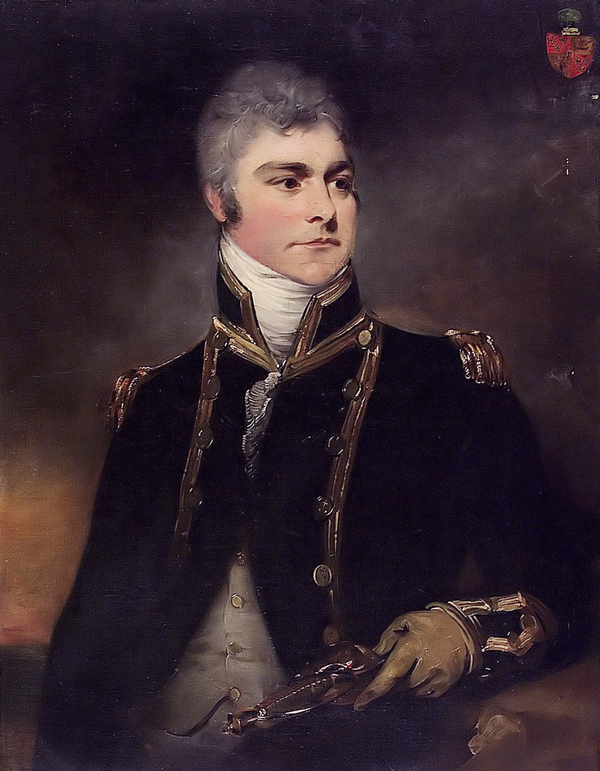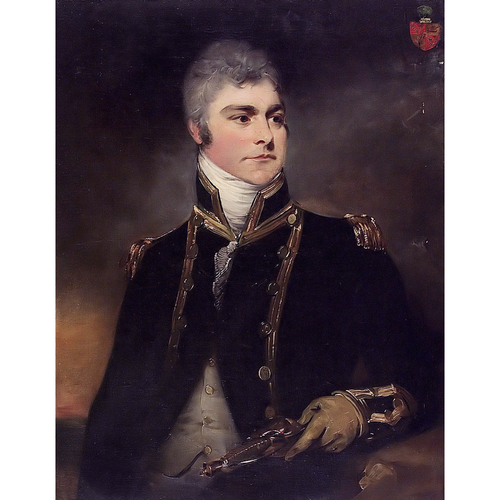
Source: Courtesy of Wikimedia Commons
HAMILTON, Sir CHARLES, naval officer and governor of Newfoundland; b. 25 May 1767, elder son of Sir John Hamilton and Cassandra Agnes Chamberlayne; m. 19 April 1803 Henrietta Martha Drummond, and they had one son; d. 14 Sept. 1849 in Iping, England.
Charles Hamilton was bred to the navy. His maternal grandfather had been an admiral and his father was a captain who earned a baronetcy for his work in the defence of Quebec in 1775–76. Charles went to sea in the summer of 1776 as a captain’s servant on his father’s ship, the Hector. From 1777 to 1779 he attended the Royal Naval Academy at Portsmouth and then rejoined the Hector as a midshipman. Between 1780 and 1810 he served in the East and West Indies, the North Sea, the Mediterranean, and off the coast of Africa, rising to become a rear-admiral and commander-in-chief on the Thames on 31 July 1810. He was promoted vice-admiral of the blue on 4 June 1814. On 25 April 1818 he became naval commander-in-chief of Newfoundland and Labrador and on 9 May was appointed governor. He arrived on 19 July, relieving acting administrator Captain John Bowker.
The policy of appointing admirals as governors has been criticized by historians of Newfoundland, who have echoed contemporary complaints that these men were, as a petition from the inhabitants of St John’s stated, “educated from their youth in a system of their own” and thus were unfit for “the exercise of that discrimination and patience so essential in the administration” of colonies. In Hamilton’s case the criticism was only partly valid. He was not without civil experience, having served as an mp for various constituencies in the south of England and in Ireland for about 13 years between 1790 and 1812, although he was on active service for most of that time. He could also claim to be “not altogether ignorant of the history of early colonization, having passed a great portion of my life in the Plantations.”
Unfortunately for Hamilton, Newfoundland’s institutions had not kept pace with the times, and his instructions were virtually identical to those given to the 18th-century governors. Hamilton was deeply conservative and he did value Newfoundland as “a good Nursery for seamen,” but he also acknowledged that it could not remain simply “a station for the seasonal fishery.” One sign that the Colonial Office had also arrived at this conclusion was that Hamilton was expected to establish a year-round residence and he was the first governor to be accompanied by his wife.
Horrified by the lack of public buildings and the narrow streets and crowded wooden houses of St John’s, Hamilton built a court-house, began work on a jail, and sought to impose a building code on the town, particularly after it was again devastated by fires in 1818 and 1819. He also supported the construction of churches by the Church of England, although he refused to expand the public education system and in 1823 protested when the Colonial Office gave a grant to the Newfoundland School Society, composed mainly of dissenters and low-church Anglicans. But most of Hamilton’s efforts at civic improvement came to little, either for lack of funds or because he could not enforce his regulations. Even after he received more extensive legal authority from parliament in 1820, he found it difficult to effect reforms: “No endeavours of mine or powers I possessed could induce the inhabitants to adopt more cleanly habits.” None the less the Hamiltons actively participated in the social life of the capital. Lady Hamilton, “the kind and constant friend of the Widow and the Orphan, was a talented artist who left for posterity a portrait of the Beothuk Demasduwit*.
Ironically Hamilton inadvertently accelerated the destruction of the Beothuks. In his eagerness to “extend to that miserable people the blessings of Civilization,” he authorized John Peyton’s ill-considered expedition in 1818. Although its main purpose was to establish friendly contacts, the mission resulted in the death of two Indians and the capture of Desmasduwit. Hamilton ordered an investigation but turned it into what was later termed a “cover-up.” He was also responsible for the equally unsuccessful expedition of Commander David Buchan in 1819–20. He did provide assistance to Shawnadithit* when she gave herself up to William Cull* in 1823.
Hamilton was unable to diversify Newfoundland’s economy. Having been instructed to promote agriculture, he soon reported that the soil was “so much worse than I had envisioned” that it was only suitable for “Grass & Potatoes.” Although he favoured small grants for fishermen, he did little to encourage such grants, and he dismissed proposals for roads into the interior as unnecessary because the island was inevitably dependent on the fisheries. The collapse of the cod market after the Napoleonic Wars led Hamilton to place greater emphasis on the rapidly expanding seal fishery and to encourage the whale and Labrador salmon fisheries. Because of the depressed economy, large numbers of destitute people had flooded into St John’s. Hamilton’s solution was to match funds raised by private subscription for the relief of the poor, while deporting as many of them as possible to the British North American colonies or the mother country. In 1822 he provided approximately £370 for relief rations in St John’s but gave more than £468 towards removing paupers from the island. Hamilton was primarily concerned with increasing government revenues, but his powers were hampered by the depression and by the legal decisions of Chief Justice Francis Forbes, including his declaring invalid the governors’ proclamations, which traditionally had been assumed to have the force of law.
Forbes’s decisions, combined with the growing outcry against the practice of appointing naval officers as surrogate judges, led the Colonial Office to revamp the legal system. Hamilton returned to London on 18 Oct. 1822 to assist in the process. However, the juridicial provisions of the 1823 Newfoundland bill owed more to Forbes and the legal adviser at the Colonial Office, James Stephen, than it did to Hamilton. With great reluctance Hamilton went back to the island in July 1823 to assess public opinion and to complete his accounts. He left again in November, returning to his family home at Iping. Although he continued to draw half pay until 5 July 1824 and was occasionally consulted by the Colonial Office, he never again held an appointment. On 22 July 1830 he became an admiral and on 19 Jan. 1833 was made a kcb. He had succeeded to the baronetcy on his father’s death in 1784.
When defending his administration, the latter part of which had been marked by political discord, Hamilton claimed in 1824 that “if the system required alteration it was no fault of mine.” Yet he cannot be absolved of all responsibility. His opposition to the proposed incorporation of St John’s was short-sighted and he stubbornly defended the surrogate system – partly because it justified a larger naval establishment – and delayed its inevitable abolition. Indeed, he probably accelerated the demand for reform by overreacting to the least sign of opposition. His prolonged dispute with William Dawe, the only trained lawyer on the island, was particularly damaging. Hamilton dismissed him from his position as notary in 1818 and later fined him for contempt when Dawe legitimately challenged the authority of a court of oyer and terminer established and presided over by Hamilton. Dawe’s heated attacks on the governor led the English reformer Joseph Hume to demand an examination of Hamilton’s accounts in 1823. Although Stephen’s investigation uncovered that Hamilton, with a salary and a vice-admiral’s pay and allowances, had been selling surplus coal purchased for Government House, it largely exonerated him of wrongdoing.
Hamilton never understood the strength of the pressure for change because he had little respect for those pushing for reform, a group he referred to as “adventurers without principle (or property . . .)” and “a few troublesome persons.” Thus it is hardly surprising that the last of the admiral-governors, even though a resident, did little to redeem the reputation of that office.
PRO, CO 194/61–72; CO 195/7. G.B., Parl., The parliamentary debates (London), [2nd] ser., 5 (1821): 1015–17; 8 (1823): 702–4; 9 (1823): 245–55. DNB. Marshall, Royal naval biog. W. R. O’Byrne, A naval biographical dictionary: comprising the life and service of every living officer in Her Majesty’s navy . . . (London, 1849). C. H. Currey, Sir Francis Forbes: the first chief justice of the Supreme Court of New South Wales (Sydney, Australia, 1968). M. A. Lewis, A social history of the navy, 1793–1815 (London, 1960). A. H. McLintock, The establishment of constitutional government in Newfoundland, 1783–1832: a study of retarded colonisation (London and Toronto, 1941). W. S. MacNutt, The Atlantic provinces: the emergence of colonial society, 1712–1857 (Toronto, 1965). Paul O’Neill, The story of St. John’s, Newfoundland (2v., Erin, Ont., 1975–76). Prowse, Hist. of Nfld. (1896). F. W. Rowe, Extinction: the Beothuks of Newfoundland (Toronto, 1977). Marjorie Smith, “Newfoundland, 1815–1840: a study of a merchantocracy” (ma thesis, Memorial Univ. of Nfld., St John’s, 1968).
Cite This Article
Phillip Buckner, “HAMILTON, Sir CHARLES,” in Dictionary of Canadian Biography, vol. 7, University of Toronto/Université Laval, 2003–, accessed January 9, 2026, https://www.biographi.ca/en/bio/hamilton_charles_7E.html.
The citation above shows the format for footnotes and endnotes according to the Chicago manual of style (16th edition). Information to be used in other citation formats:
| Permalink: | https://www.biographi.ca/en/bio/hamilton_charles_7E.html |
| Author of Article: | Phillip Buckner |
| Title of Article: | HAMILTON, Sir CHARLES |
| Publication Name: | Dictionary of Canadian Biography, vol. 7 |
| Publisher: | University of Toronto/Université Laval |
| Year of publication: | 1988 |
| Year of revision: | 1988 |
| Access Date: | January 9, 2026 |



